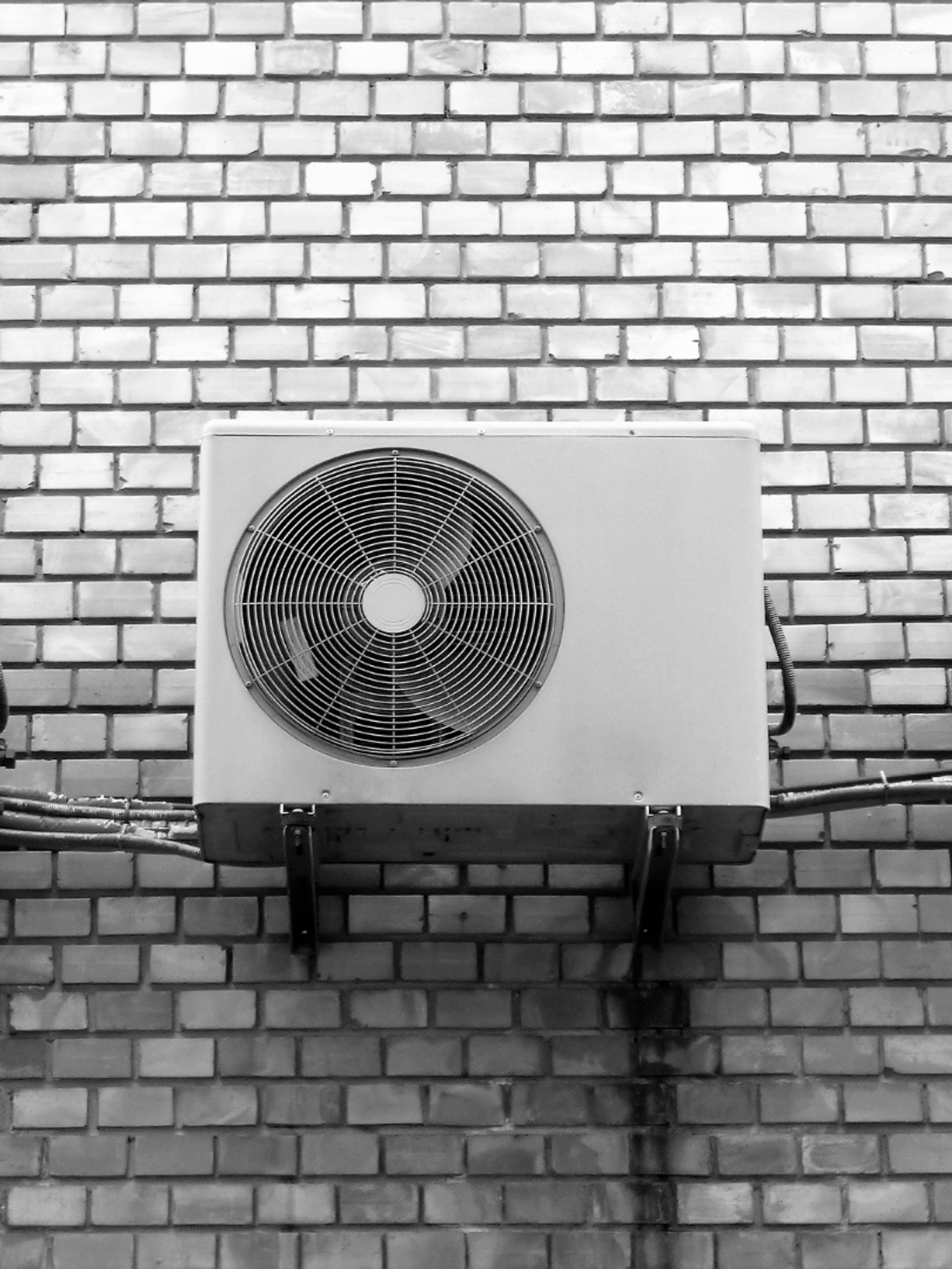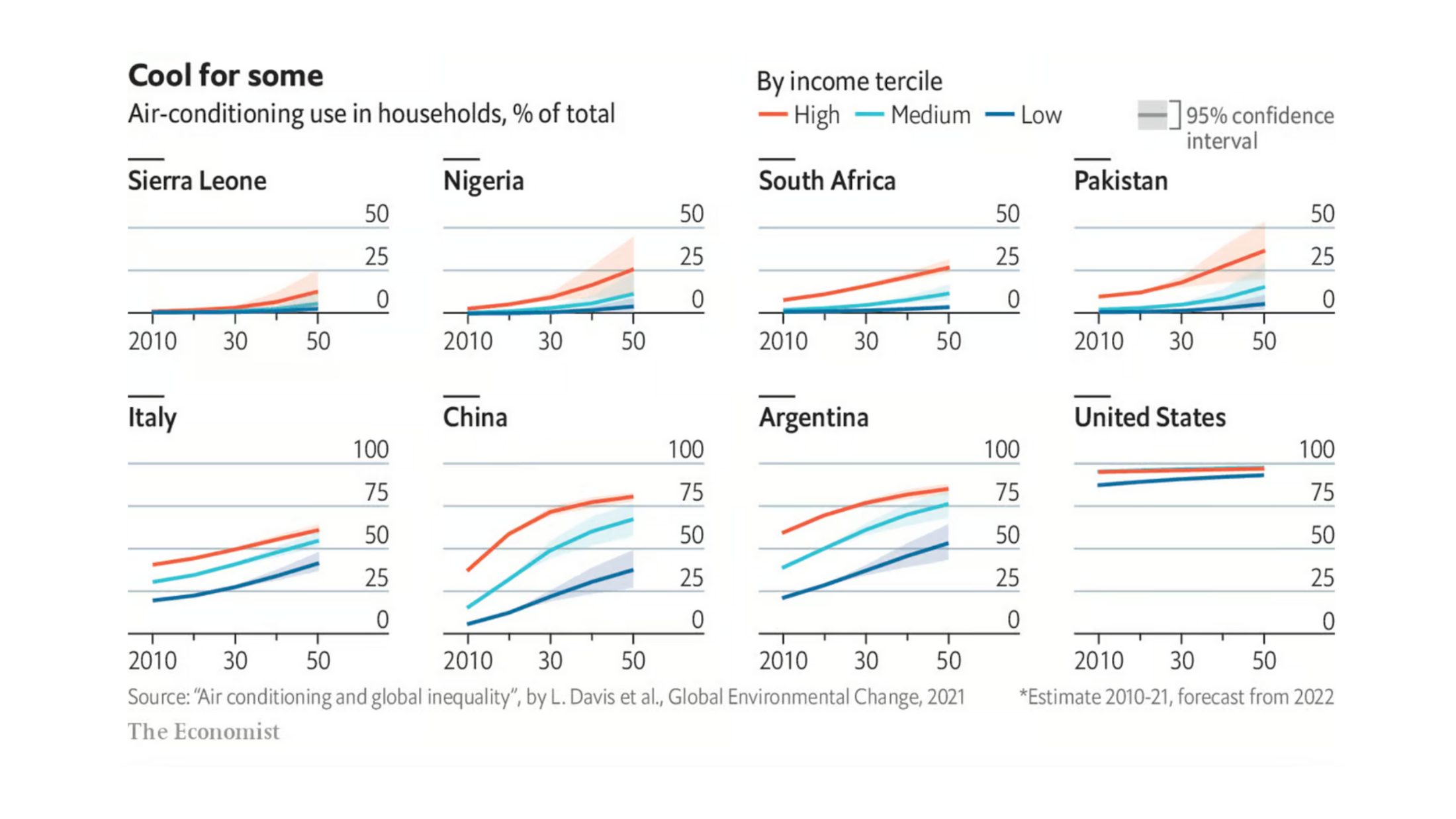Cooling Without Warming
In a warming world, we need new environmentally benign air conditioning technologies
Written by Walter D. Johnsen, PhD
on September 25, 2024


With warming surface temperatures, access to air conditioning will be non-negotiable. Annual heat-related deaths are expected to increase by 370% before mid-century, impacting up to 525 M people. Air conditioning will be vital to prevent this and adapt.
Additionally, air conditioning has tangible benefits to users. Studies have revealed that access to air conditioning increases life expectancy, is correlated with higher academic achievements among children in school, and grows GDP.
Yet, it turns out that while air conditioning is critical to adaptation, it is taxing to our energy infrastructure and extremely harmful to the climate.
AC Use May Compromise Our Climate Goals
Heating and cooling our built environment represent the largest energy expenditure for buildings. To put numbers on this, one study revealed that in 2016 air conditioning consumed over 2,020 TWh globally - that’s over 4 times what all of France consumed in 2023!
With our current energy composition, electricity spent towards air conditioning correlates to an annual carbon footprint of over 1.1 Gt of carbon dioxide. The large energy needs of air conditioners have driven power demand beyond grid capacity, stressed power grids, and even caused blackouts on sweltering days.
Beyond electricity usage, conventional air conditioners are reliant on working fluids called refrigerants. The most common types of refrigerants — chloroflourocarbons, hydrochloroflourocarbons, and hydroflourocarbons — have extremely high 100-year global warming potentials (GWP100: 2,000 - 10,000). Refrigerants are emitted into the atmosphere through leakage and improper disposal at end of life. Project Drawdown calculates that preventing the use of refrigerants in cooling across all use cases (AC, refrigeration, etc) could abate up to 57 Gt CO2e emissions over the next 30 years.
Taken together, air conditioning is responsible for more than 1.8 Gt CO2 emissions annually!
Surging Demand Compounds the Problem
Driven by climate change, increased urbanization, and GDP per capita growth, air conditioner use is forecasted to grow by 3 to 5x over the next 25 years. The growth will be most pronounced in emerging markets - locales where current energy grids are unlikely to support the electricity needs of conventional air conditioners.

Figure 1: Forecast of growth in the air conditioning market penetration by income percentile over time. Source: Economist 2022
Transformative Technologies for Air Conditioning
To equitably deploy air conditioning to regions most at risk of warming temperatures while reducing their emissions intensity, new cooling systems must have lower energy requirements and environmentally benign (or no) refrigerants.
Clean cooling technologies have been developed in the lab over the past 50 years. From completely solid-state technologies to refrigerants with only modest global warming potentials, researchers have been able to create radically cleaner and lower-polluting air conditioning technologies.
Currently, new cooling technologies can divided into four key categories: new driving forces, low-carbon heat integration, new refrigerants, and desiccants. Each has unique advantages and disadvantages (Figure 2).
Desiccants: Desiccants dehumidify air prior to cooling via conventional air conditioning technologies, thereby making the vapor compression cycle drastically more energy efficient (>80%). This technology can be used to retrofit existing air conditioners or integrated with new technologies to make even more efficient systems.
Historically, regenerating the desiccant required more energy than what was saved during the cooling cycle. However, new MOF and liquid desiccants have significantly reduced the energetic needs of the regeneration step, renewing interests in desiccant cooling.
An additional advantage is the energy used to regenerate the system can be temporally separated from when the device is providing cooling. As such, desiccant cooling could help manage and smooth grid load fluctuations.
New Driving Forces: Stimuli - beyond standard compression and decompression of gases - create phase changes that can be harnessed to drive cooling cycles.
Examples include magnetocaloric, where a magnetic field drives a state change, in doing so releasing or absorbing heat. Another, barocaloric, creates a cooling cycle through pressure which converts a solid from one morphology to another morphology. Then there are even newer forms of cooling like ionocaloric and elastocaloric. In ionocaloric, electrochemistry provides the underlying mechanism in cooling, while elastocaloric uses heat released upon application of tensile strain.
New Refrigerants: Refrigerants with low or zero global warming potentials (GWP) act as a 1-to-1 replacement for current refrigerants. An ideal next-generation refrigerant is a non-toxic, inflammable, and a liquid at room temperature. Additionally, the refrigerant has a low boiling point and possesses a large specific heat. Examples of new refrigerants include water, nitrogen gas, carbon dioxide, and ammonia.
Low Carbon Heat Integration: Coupling waste heat or low-carbon heat sources with status-quo air conditioners can drive highly efficient vapor-compression cooling cycles. Today, sunlight, geothermal, and waste heat from data centers are all being investigated for their ability to couple with districted air conditioning systems and are shown to lower energy usage by as much as 50%.
Across all the technological solutions, desiccants and new driving forces offer the greatest potential for emissions reduction and step-change improvements to energy efficiency.

Figure 2: A summary of emergent cooling technologies that are applicable for air conditioning built environments.
Map of Emergent Active Cooling Companies
Over 20 startups are launching new game-changing active cooling solutions (Figure 3). To develop a right to win in an otherwise consolidated industry, start-ups are identifying beachhead markets that align with core IP, creating phased R&D roadmaps, developing integrated business models that sell directly to the end user, and structuring product offerings to minimize risk to consumers.
And preliminarily, the strategies have worked. Many startups have secured venture capital investments and developed prototypes. More excitingly, companies such as Gradient and Blue Frontier are already delivering their highly energy efficient air conditioners to customers.

Figure 3: A non-comprehensive list of emergent cooling companies reveals many successful raises and transformative technologies.
Challenges to Commercialising New Cooling Technologies
The air conditioning sector is particular challenging for emerging players because:
A Consolidated and Aggressive Industry: A survey of air conditioning suppliers and manufacturers reveals a shockingly consolidated industry, with less than 500 companies globally. Further up the supply chain, the industry is even more consolidated with just 5 major producers of rotary compressors — a key component of current air conditioners. Extremely aggressive tactics have prevented new players with transformative solutions from entering the industry. For example, major cooling companies have ruthlessly imitated technologies of start up companies and then undersold them (Figure 4).
CapEx-First Decision Making: When purchasers evaluate air conditioners, they value upfront costs above all else in what is known as “CapEx-First” decision-making. Innovation among the major air conditioning manufacturers has up until now almost exclusively focused on lowering production costs to make cheaper devices.
Engrained Channels and Misaligned Incentives: The supply chain from AC manufacturer to end user is deeply engrained and involves multiple stakeholders. Stakeholders are often risk adverse to new air conditioning technologies. Additionally, to launch a new technology will require creating and training HVAC support networks.

Figure 4: Gradient’s prototype (left) has been imitated by countless majors including Midea (right). Source: Utility Dive
At Marble, We Aim to Build a Cooling Company in 2025
We are convinced that we cannot wait any longer to build a clean and efficient air conditioning technology company. Leveraging our newly gained insights, we propose to develop a completely refrigerant free and highly efficient technology.
Apply now!Acknowledgements: I’d like to thank Nina Ali (First Matter), Guillaume Bazouin (Brick & Mortar), Jacob Bro (2150), Brett Clarke (VoLo Ventures), Chloe Coates (Zero Carbon Capital), Yulong Ding (University of Birmingham), Eric Dusseux (Breakthrough Energy), Petros Farah (Samsung Ventures), Nicole Florack (2150), Ankit Kalanki (RMI), Patricia Kroondijk (Hitachi Ventures), Jesus Lizana (Oxford), Berardo Metalucci (MiMic Systems), Valetine Piperno (VINCI), Lindsay Ramussen (Third Derivative), Florian Schabus (Barocal), Adam Slavney (Pascal), and Trevor Wende (Mojave Energy Systems) for insightful conversations and great insights.
Finally, thank you to Jonny Everett, Abhinav Jain, Fatoumata Traore, Ben Tincq, Malika Vassilova, and the rest of the Marble team for reviewing many drafts of this article.
